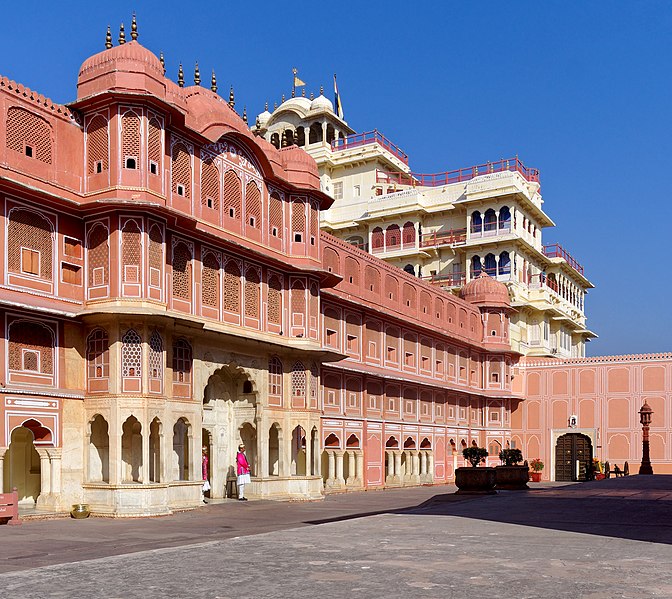The City Palace in Jaipur stands as a majestic testament to the opulence, grandeur, and rich history of the Pink City, serving as a prominent architectural marvel and a living legacy of the royal heritage of Rajasthan. Nestled in the heart of Jaipur, the capital city of the Indian state of Rajasthan, the City Palace is a sprawling complex that seamlessly blends Rajput, Mughal, and European architectural styles, reflecting the diverse influences that have shaped the region over centuries.
Built by Maharaja Sawai Jai Singh II, the founder of Jaipur, the construction of the City Palace began in the early 18th century and continued over several generations of the ruling Maharajas. The palace complex comprises a series of courtyards, gardens, palaces, and buildings, each adding to the architectural magnificence of the overall structure.
The main entrance to the City Palace is through the imposing Mubarak Mahal, a beautiful palace that once served as a reception area for the royal guests. This section now houses the Maharaja Sawai Man Singh II Museum, which displays an extensive collection of royal costumes, textiles, and artifacts, offering visitors a glimpse into the extravagant lifestyle of the Rajput rulers.
One of the striking features of the City Palace is its Chandra Mahal, a seven-storied palace that dominates the skyline of Jaipur. The Chandra Mahal is the residence of the present Maharaja of Jaipur and is a fine example of Rajput architecture. The intricately carved doorways, delicate mirror work, and vibrant color schemes within the palace showcase the artistic finesse of the craftsmen of that era.
The Peacock Gate (Mor Gate) is another noteworthy attraction within the City Palace complex. This intricately designed gate is adorned with colorful peacock motifs, symbolizing grace and beauty. It leads to the inner courtyard, Sarvato Bhadra, which features four beautifully painted doorways representing the four seasons.
The Diwan-i-Khas, or Hall of Private Audience, is a hall adorned with stunning crystal chandeliers, mirrored walls, and exquisite paintings. This hall served as a meeting place for the Maharaja to discuss matters of state with his trusted advisors. The Diwan-i-Aam, or Hall of Public Audience, is another significant structure where the Maharaja would address the general public.
The City Palace also houses the Pritam Niwas Chowk, a courtyard surrounded by four gates, each dedicated to a different season and adorned with unique motifs and colors. The gates are named Peacock Gate (representing autumn), Lotus Gate (representing summer), Green Gate (representing spring), and Rose Gate (representing winter).
A highlight of the City Palace is the Jantar Mantar, an observatory built by Maharaja Sawai Jai Singh II. It is a UNESCO World Heritage Site and features a collection of architectural astronomical instruments, including the world’s largest stone sundial, which accurately measures time with remarkable precision.
The City Palace is not just a historical monument but a living heritage that continues to be associated with the royal family of Jaipur. The blend of traditional Rajput and Mughal architecture, along with European influences, creates a visual spectacle that attracts history enthusiasts, architecture aficionados, and tourists from around the world.
In addition to its architectural splendor, the City Palace hosts cultural events, festivals, and functions that showcase the rich cultural heritage of Rajasthan. The palace complex, with its courtyards, museums, and galleries, provides a comprehensive experience of the royal lifestyle, offering a journey through the annals of history in the vibrant city of Jaipur. The City Palace stands as a testament to the enduring legacy of Rajasthan’s royal past, inviting visitors to step into the opulent world of the Maharajas.

